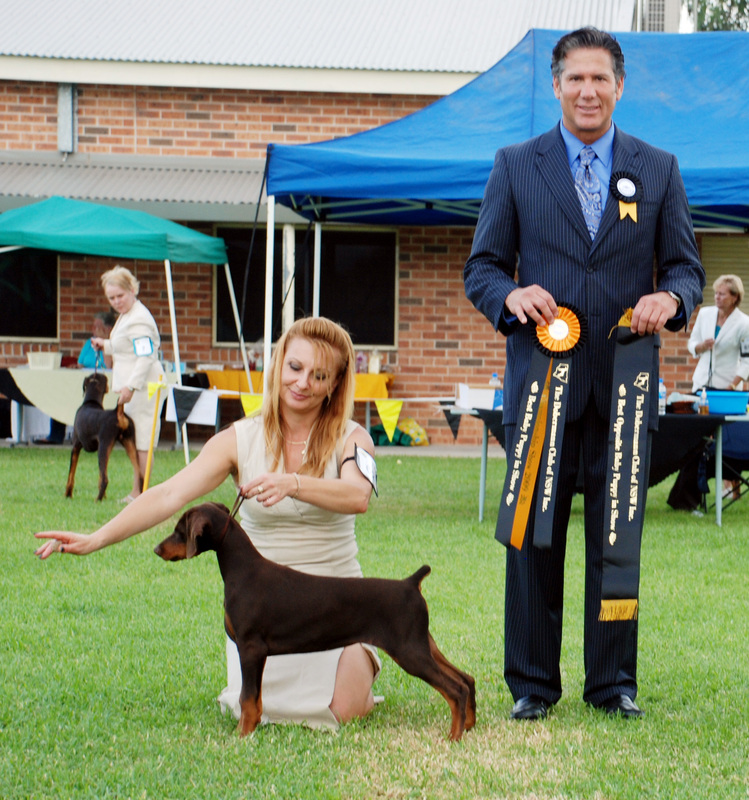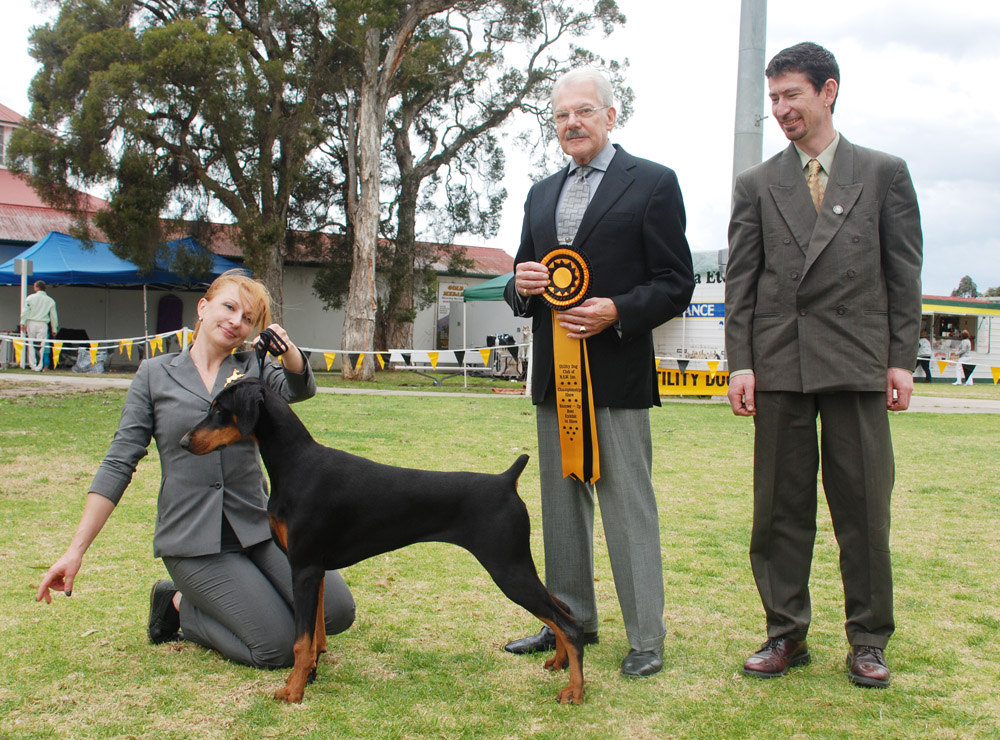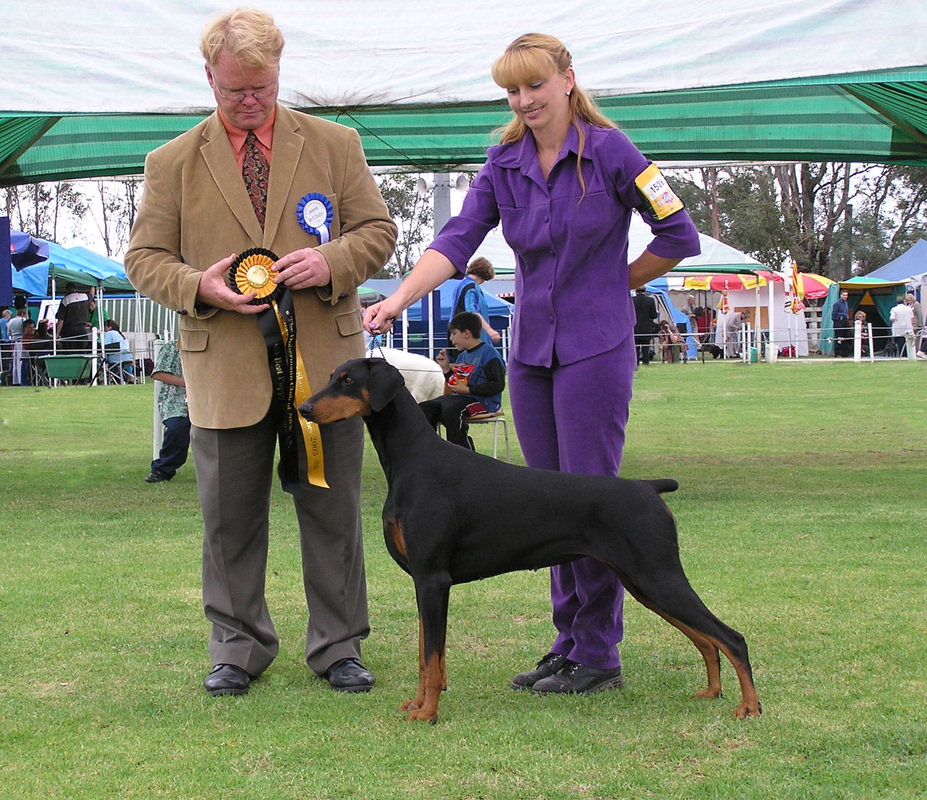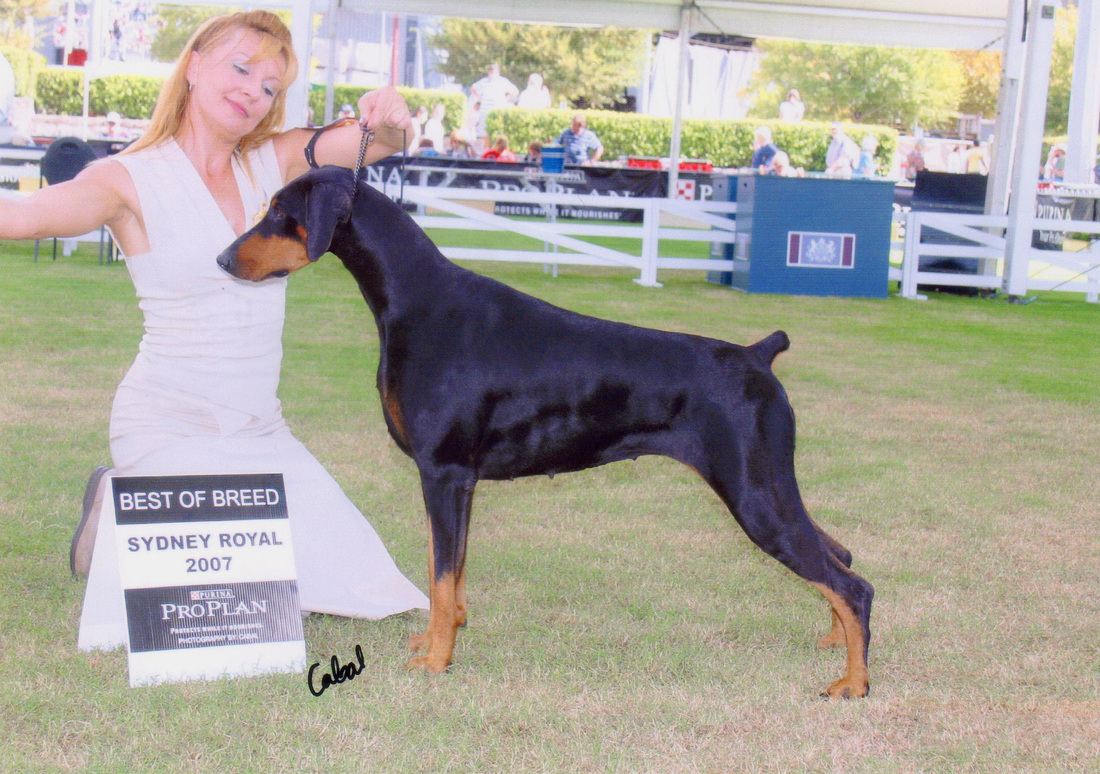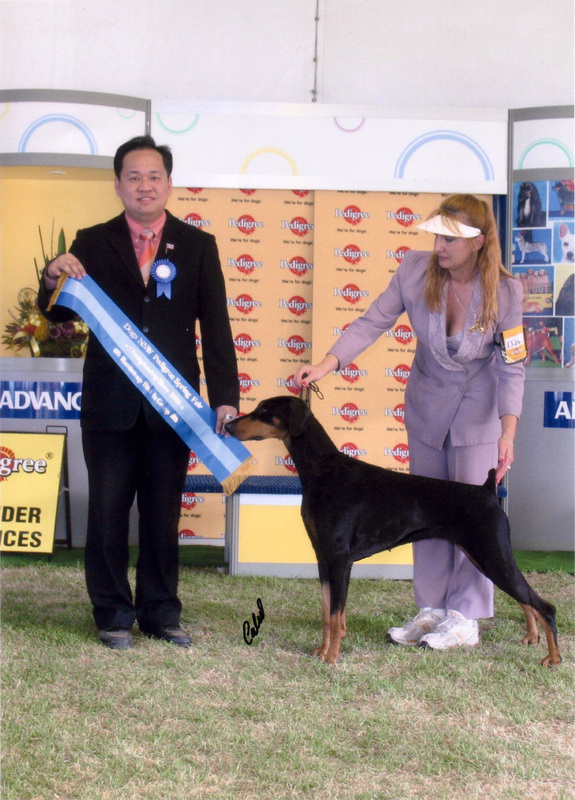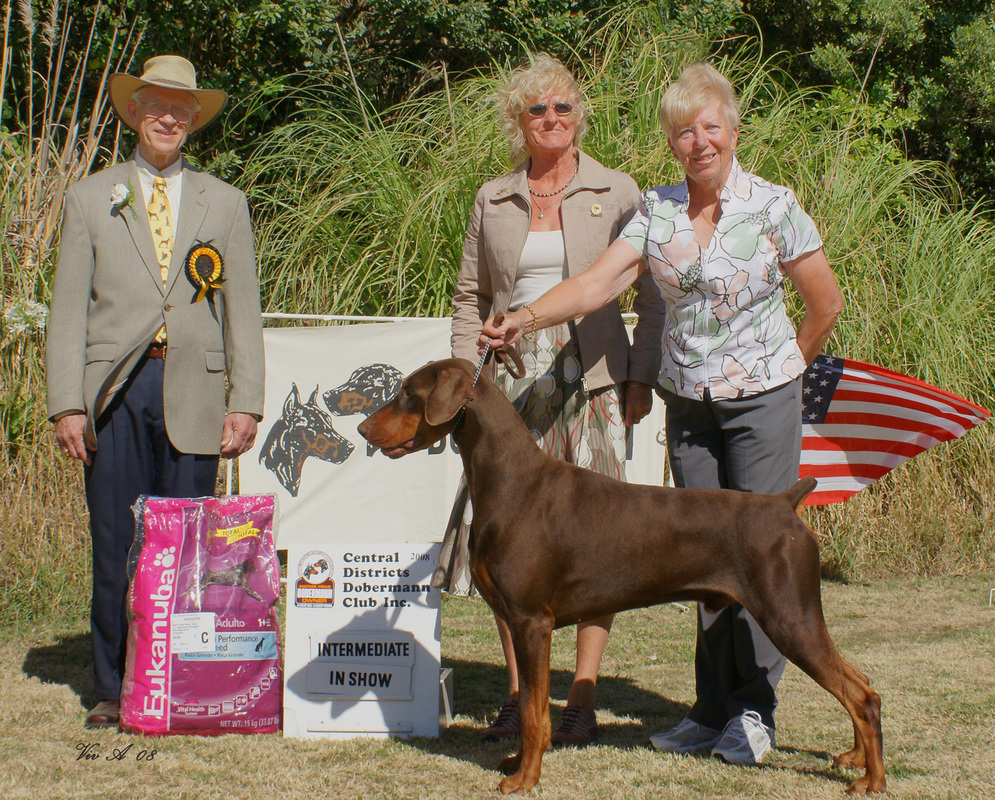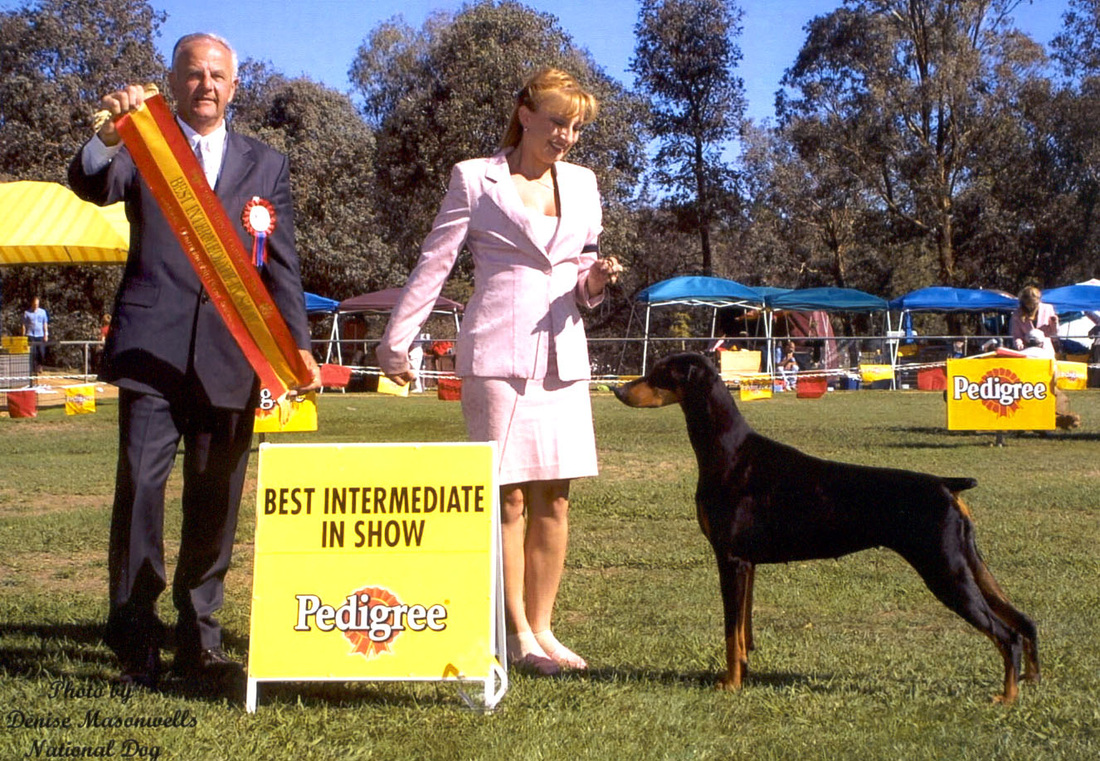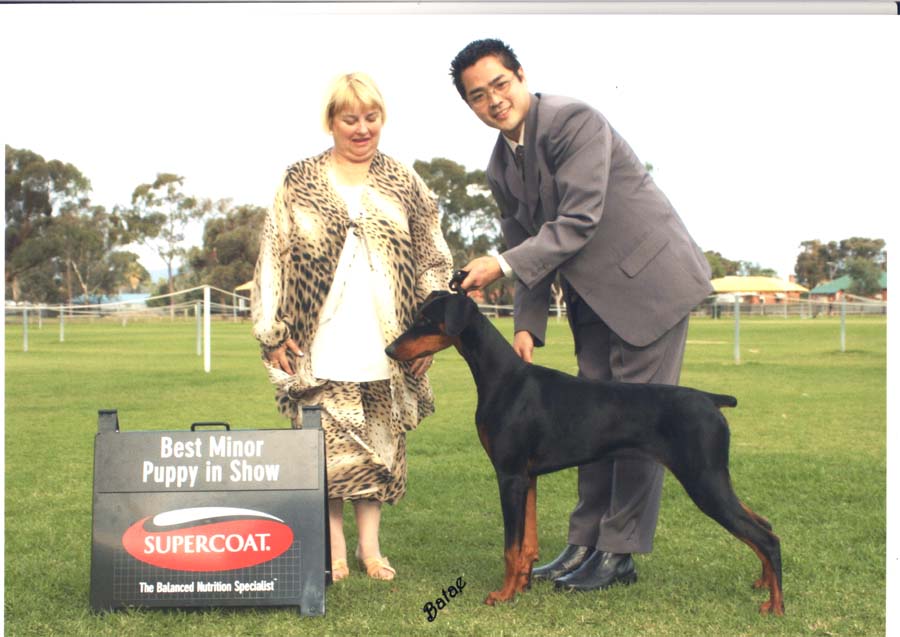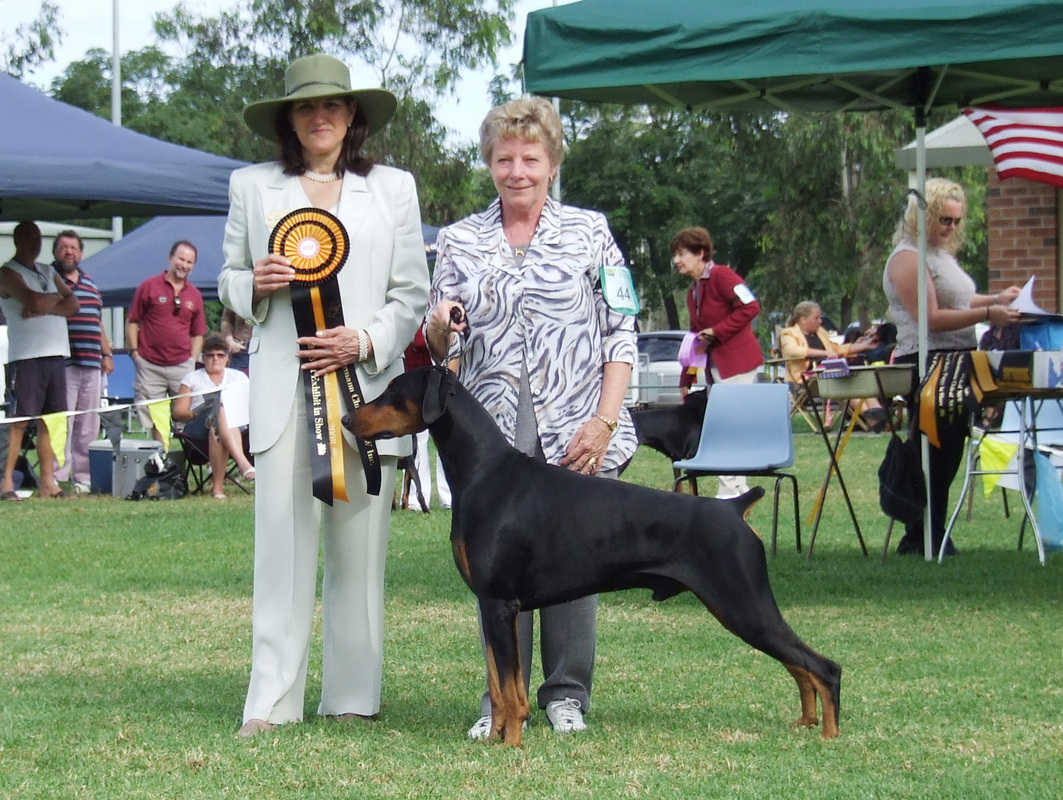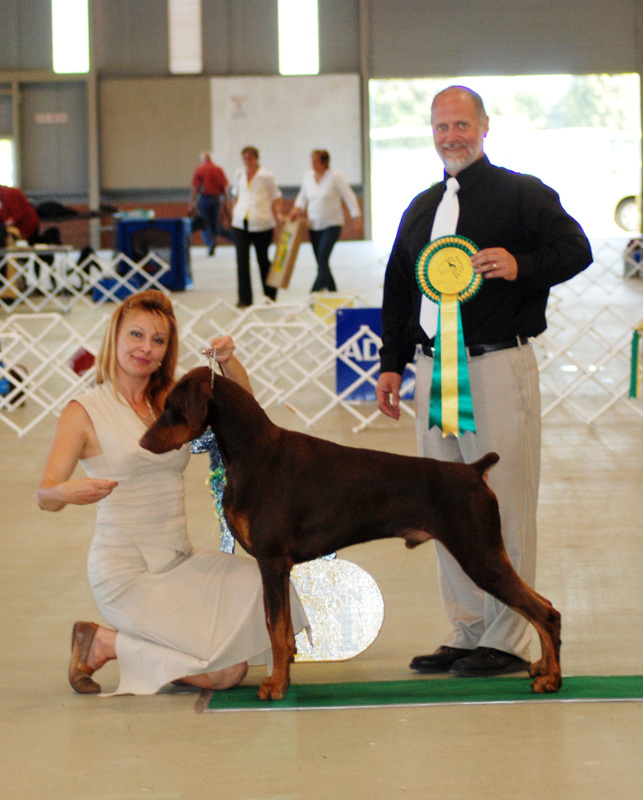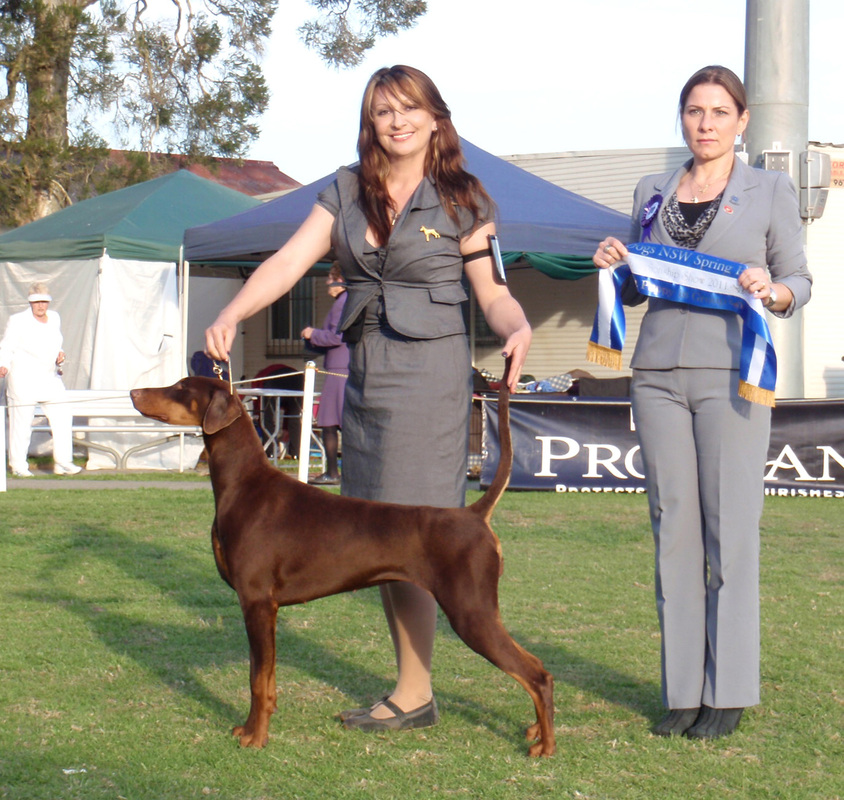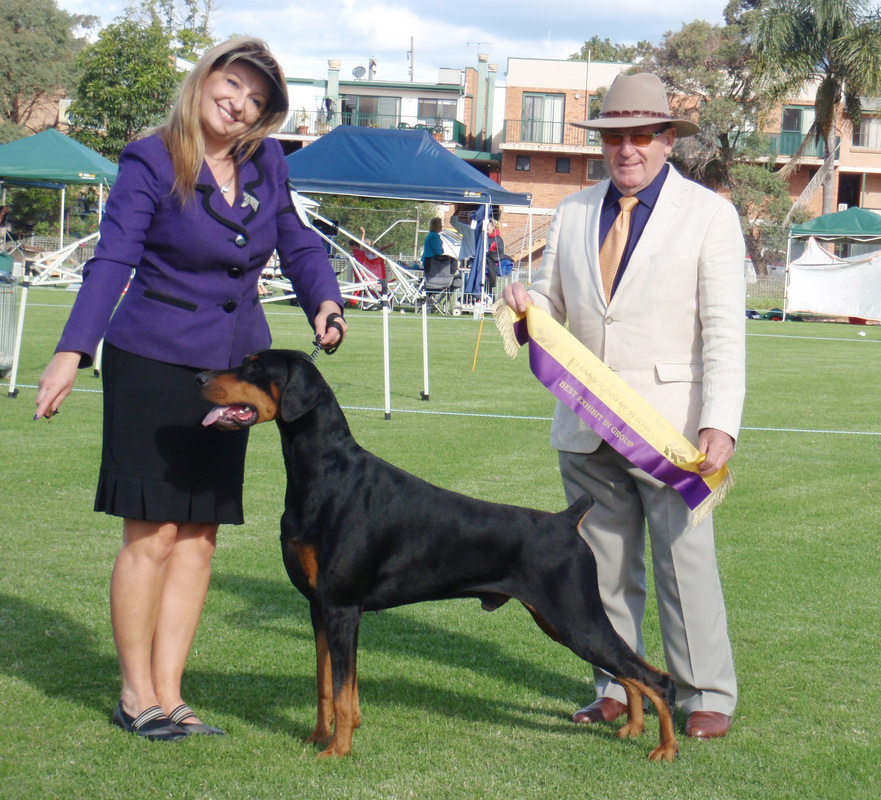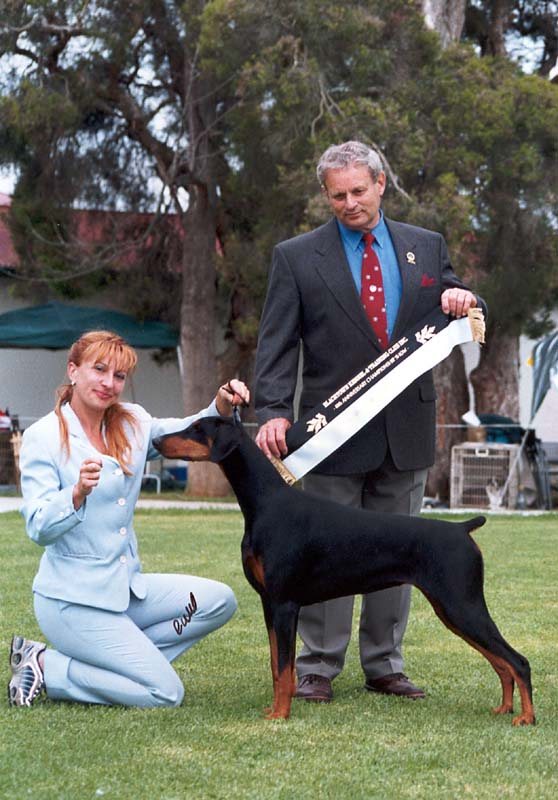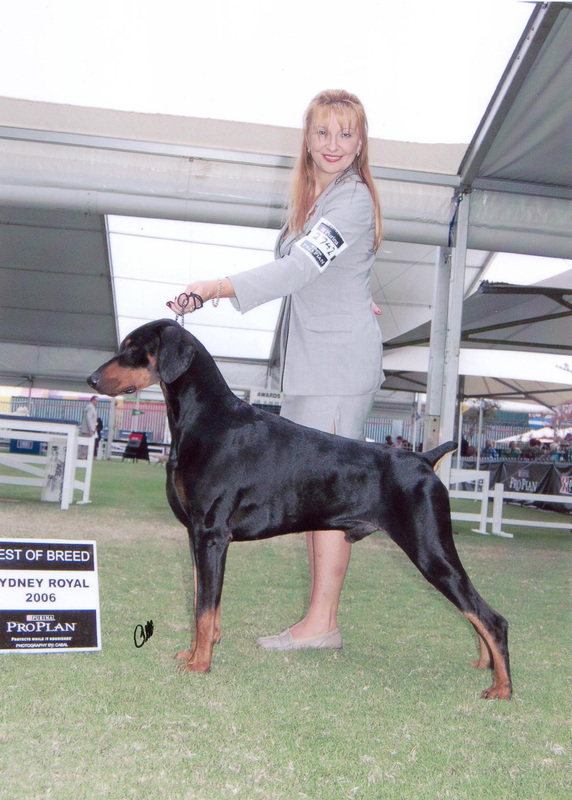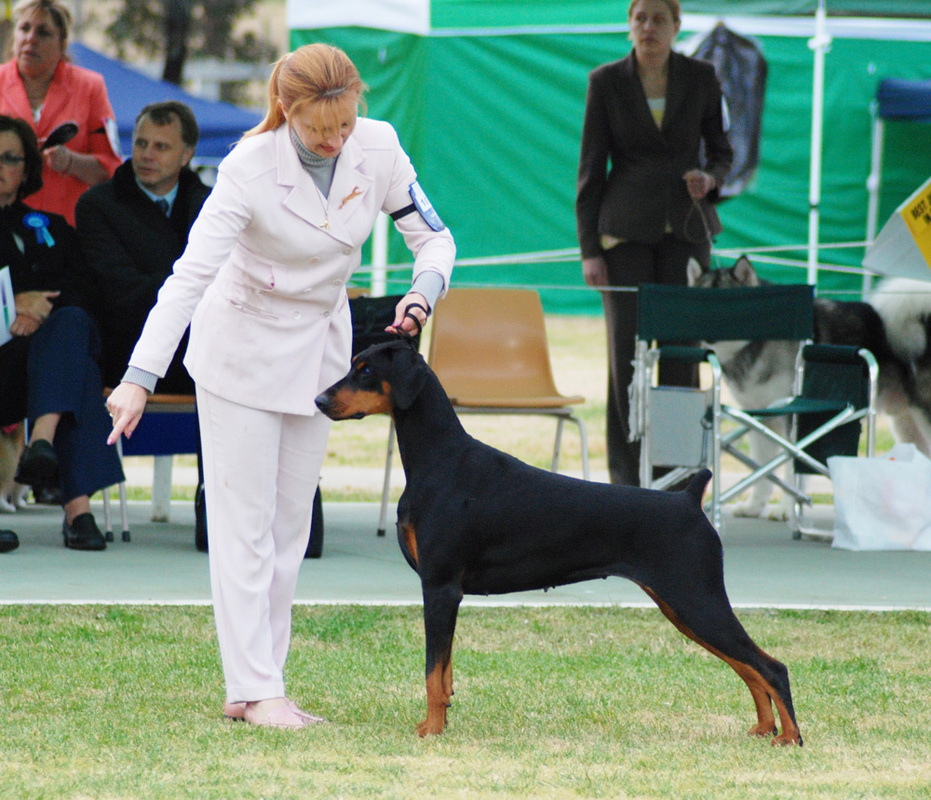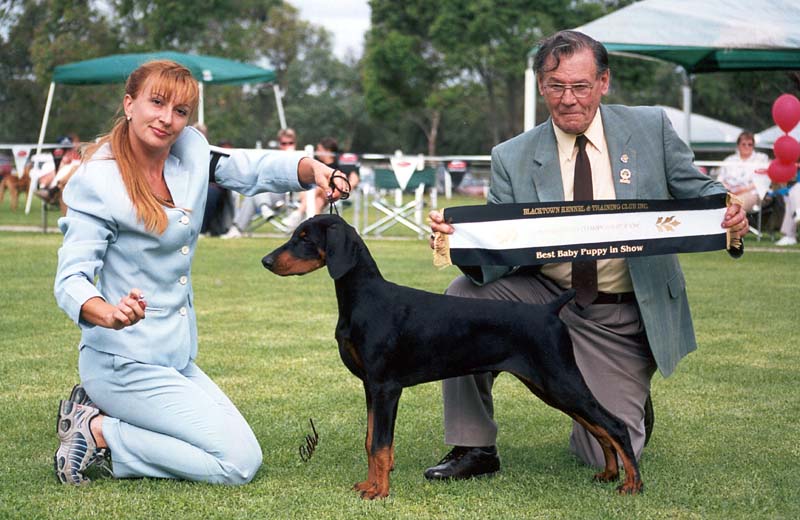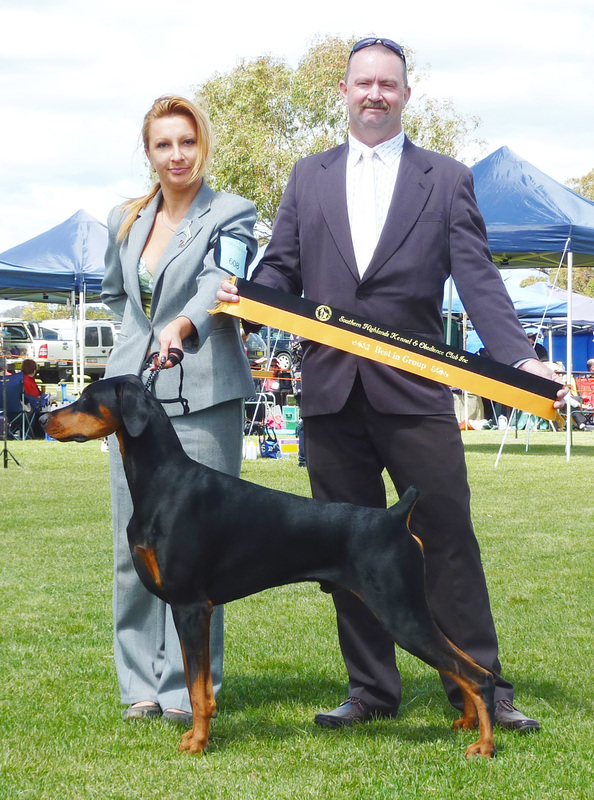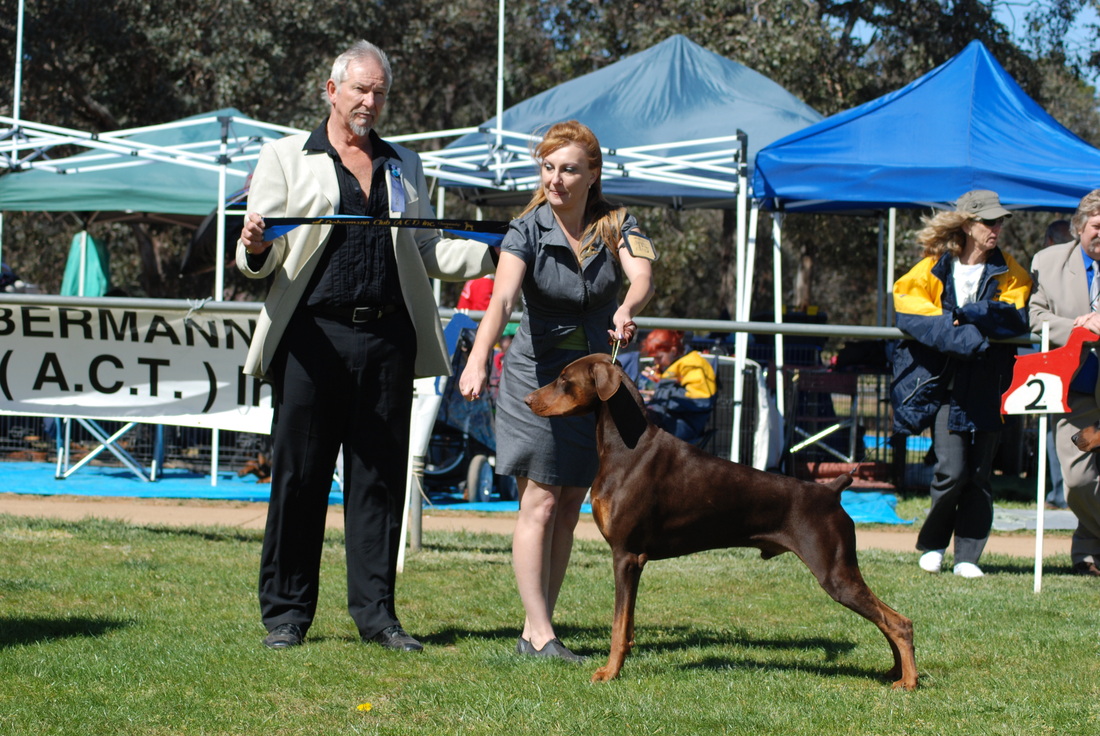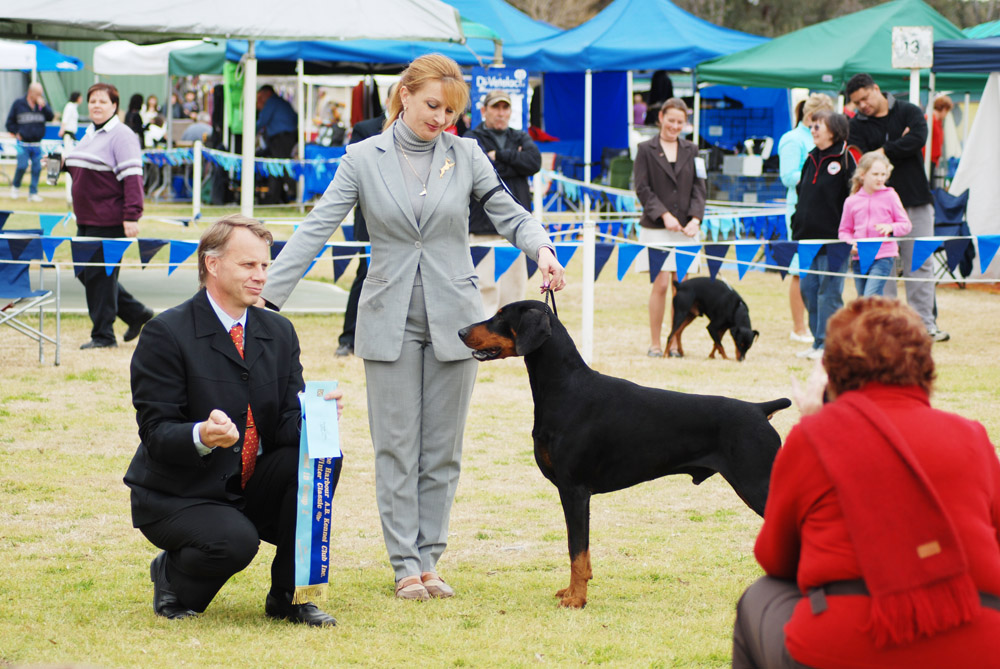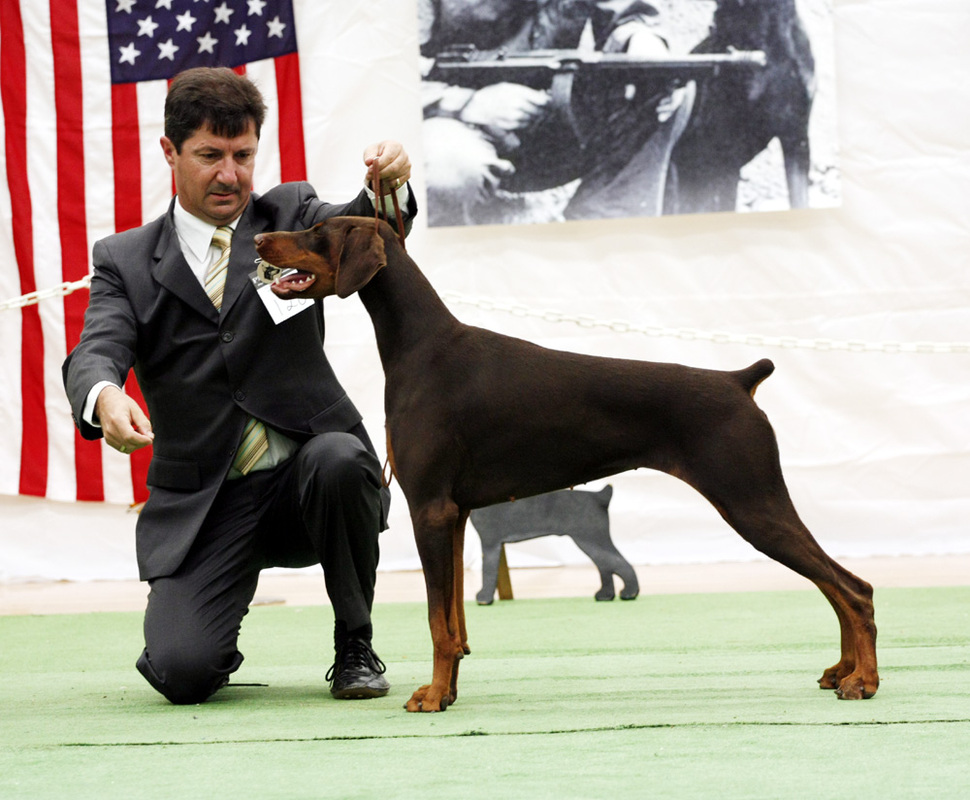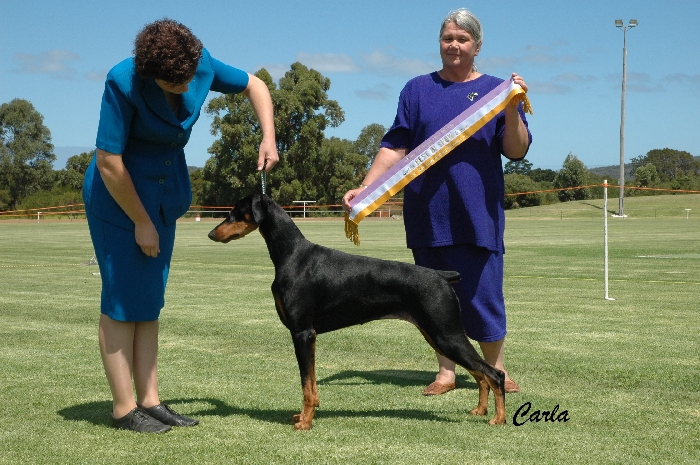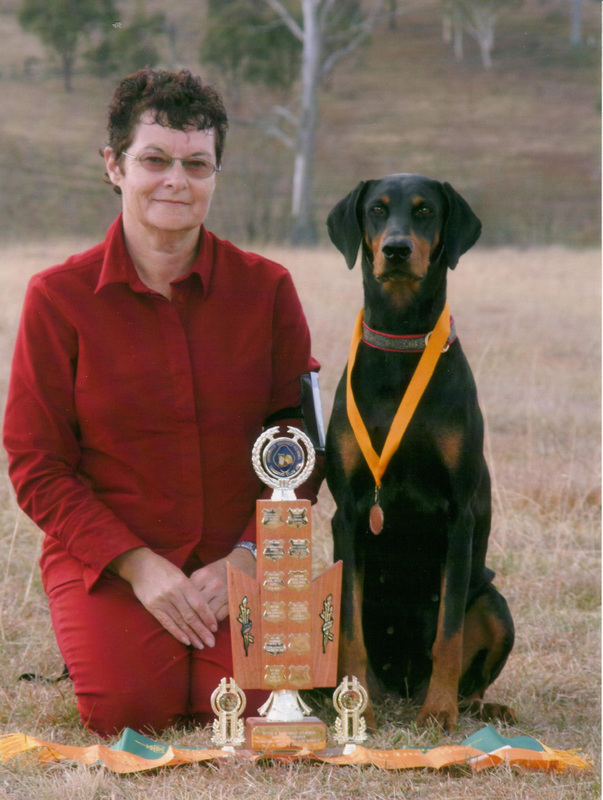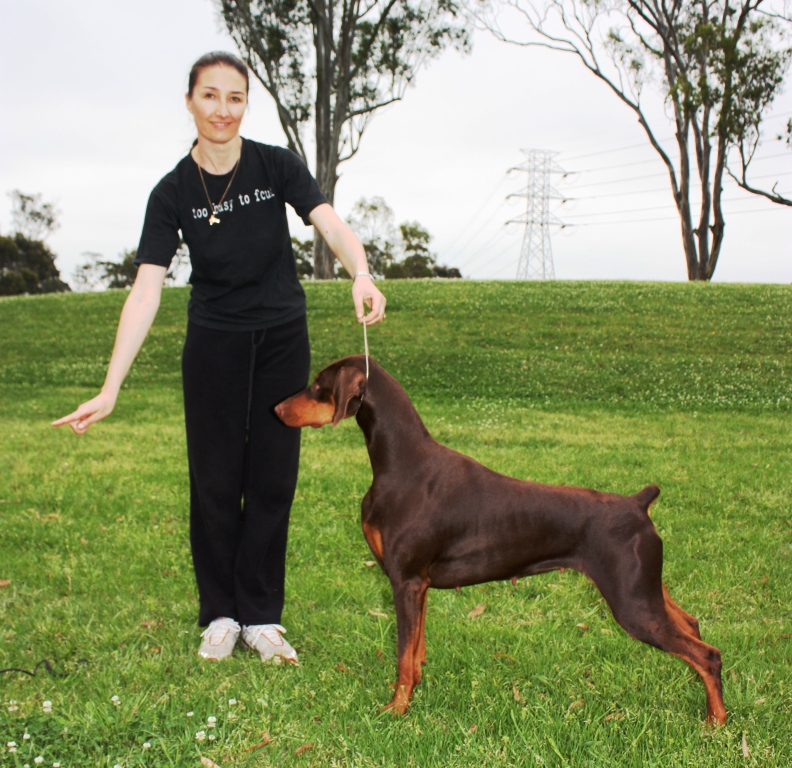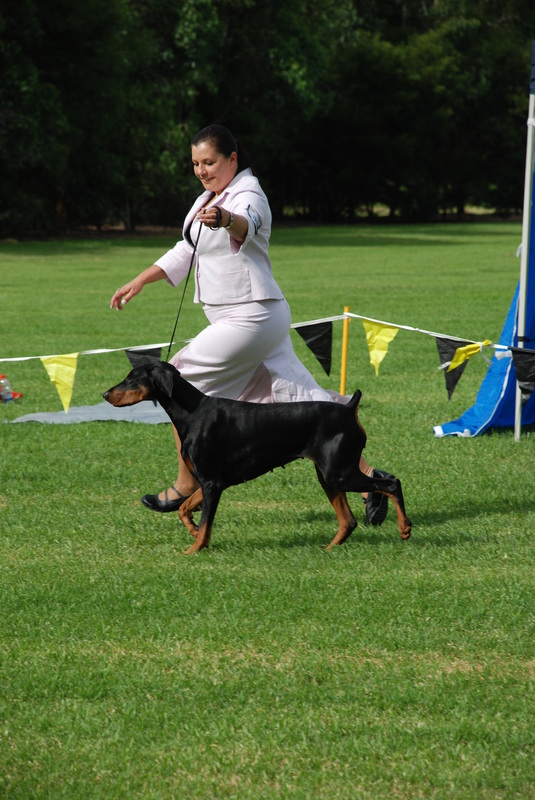Dobermann Standards!
There are several standards all over the world (see below) they are similar however have slight variations. I prefer Dobermanns with substance and this is reflected in my breeding. However with too much size and substance you loose the agility speed and stamina the Dobermann has to have! I always say they are the sports cars of the Dog world!
I look at Dobermanns the world has to offer and like to combine all the things I beleiev will improve the breed. This is reflected in the fact that I import a lot of dogs from different countries I also do this as we need new genes introduced into this breed. Australia is rather isolated, we do not have access to the variety of different genes as many of the other countries do. It is very important to introduce genes that are completely different to what we have here.
The European Dobermann Standard FCI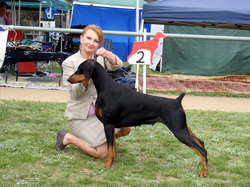
Working Group General Appearance The appearance is that of a dog of medium size, with a body that is square. Compactly built, muscular and powerful, for great endurance and speed. Elegant in appearance, of proud carriage, reflecting great nobility and temperament. Energetic, watchful, determined, alert, fearless, loyal and obedient. Size, Proportion, Substance Height at the withers: Dogs 26 to 28 inches, ideal about 27½ inches; Bitches 24 to 26 inches, ideal about 25½ inches. The height, measured vertically from the ground to the highest point of the withers, equalling the length measured horizontally from the forechest to the rear projection of the upper thigh. Length of head, neck and legs in proportion to length and depth of body. Head Long and dry, resembling a blunt wedge in both frontal and profile views. When seen from the front, the head widens gradually toward the base of the ears in a practically unbroken line. Eyes almond shaped, moderately deep set, with vigorous, energetic expression. Iris, of uniform color, ranging from medium to darkest brown in black dogs; in reds, blues, and fawns the color of the iris blends with that of the markings, the darkest shade being preferable in every case. Ears normally cropped and carried erect. The upper attachment of the ear, when held erect, is on a level with the top of the skull. Top of skull flat, turning with slight stop to bridge of muzzle, with muzzle line extending parallel to top line of skull. Cheeks flat and muscular. Nose solid black on black dogs, dark brown on red ones, dark gray on blue ones, dark tan on fawns. Lips lying close to jaws. Jaws full and powerful, well filled under the eyes. Teeth strongly developed and white. Lower incisors upright and touching inside of upper incisors a true scissors bite. 42 correctly placed teeth, 22 in the lower, 20 in the upper jaw. Distemper teeth shall not be penalized. Disqualifying Faults: Overshot more than 3/16 of an inch. Undershot more than 1/8 of an inch. Four or more missing teeth. Neck, Topline, Body Neck proudly carried, well muscled and dry. Well arched, with nape of neck widening gradually toward body. Length of neck proportioned to body and head. Withers pronounced and forming the highest point of the body. Back short, firm, of sufficient width, and muscular at the loins, extending in a straight line from withers to the slightly rounded croup. Chest broad with forechest well defined. Ribs well sprung from the spine, but flattened in lower end to permit elbow clearance. Brisket reaching deep to the elbow. Belly well tucked up, extending in a curved line from the brisket. Loins wide and muscled. Hips broad and in proportion to body, breadth of hips being approximately equal to breadth of body at rib cage and shoulders. Tail docked at approximately second joint, appears to be a continuation of the spine, and is carried only slightly above the horizontal when the dog is alert. Forequarters Shoulder Blade - sloping forward and downward at a 45-degree angle to the ground meets the upper arm at an angle of 90 degrees. Length of shoulder blade and upper arm are equal. Height from elbow to withers approximately equals height from ground to elbow. Legs seen from front and side, perfectly straight and parallel to each other from elbow to pastern; muscled and sinewy, with heavy bone. In normal pose and when gaiting, the elbows lie close to the brisket. Pasterns firm and almost perpendicular to the ground. Dewclaws may be removed. Feet well arched, compact, and catlike, turning neither in nor out. Hindquarters The angulation of the hindquarters balances that of the forequarters. Hip Bone falls away from spinal column at an angle of about 30 degrees, producing a slightly rounded, well filled-out croup. Upper Shanks at right angles to the hip bones, are long, wide, and well muscled on both sides of thigh, with clearly defined stifles. Upper and lower shanks are of equal length. While the dog is at rest, hock to heel is perpendicular to the ground. Viewed from the rear, the legs are straight, parallel to each other, and wide enough apart to fit in with a properly built body. Dewclaws, if any, are generally removed. Cat feet as on front legs, turning neither in nor out. Coat Smooth-haired, short, hard, thick and close lying. Invisible gray undercoat on neck permissible. Color and Markings Allowed Colors: Black, red, blue, and fawn (Isabella). Markings: Rust, sharply defined, appearing above each eye and on muzzle, throat and forechest, on all legs and feet, and below tail. White patch on chest, not exceeding ½ square inch, permissible. Disqualifying Fault: Dogs not of an allowed color. Gait Free, balanced, and vigorous, with good reach in the forequarters and good driving power in the hindquarters. When trotting, there is strong rear-action drive. Each rear leg moves in line with the foreleg on the same side. Rear and front legs are thrown neither in nor out. Back remains strong and firm. When moving at a fast trot, a properly built dog will single-track. Temperament Energetic, watchful, determined, alert, fearless, loyal and obedient. The judge shall dismiss from the ring any shy or vicious Doberman. Shyness: A dog shall be judged fundamentally shy if, refusing to stand for examination, it shrinks away from the judge; if it fears an approach from the rear; if it shies at sudden and unusual noises to a marked degree. Viciousness: A dog that attacks or attempts to attack either the judge or its handler, is definitely vicious. An aggressive or belligerent attitude towards other dogs shall not be deemed viciousness. Faults The foregoing description is that of the ideal Doberman Pinscher. Any deviation from the above described dog must be penalized to the extent of the deviation. Disqualifications Overshot more than 3/16 of an inch, undershot more than 1/8 of an inch. Four or more missing teeth. Dogs not of an allowed color. Approved February 6, 1982 Reformatted November 6, 1990 (http://www.akc.org/breeds/doberman_pinscher/index.cfm) American Standard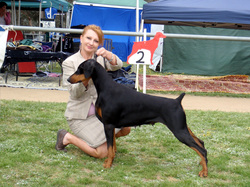
Official AKC Standard of the Doberman Pinscher(Adopted February 6, 1982)GENERAL APPEARANCEThe appearance is that of a dog of medium size, with a body that is square. Compactly built, muscular and powerful, for great endurance and speed. Elegant in appearance, of proud carriage, reflecting great nobility and temperament. Energetic, watchful, determined, alert, fearless, loyal and obedient.SIZE, PROPORTION, SUBSTANCEHeight at the withers: Dogs 26 to 28 inches, ideal about 27 1/2 inches; Bitches 24 to 26 inches, ideal about 25 1/2 inches. The height, measured vertically from the ground to the highest point of the withers, equaling the length measured horizontally from the forechest to the rear projection of the upper thigh. Length of head, neck and legs in proportion to length and depth of body.HEADLong and dry, resembling a blunt wedge in both frontal and profile views. When seen from the front, the head widens gradually toward the base of the ears in a practically unbroken line. Eyes almond shaped, moderately deep set, with vigorous, energetic expression. Iris, of uniform color, ranging from medium to darkest brown in black dogs; in reds, blues, and fawns the color of the iris blends with that of the markings, the darkest shade being preferable in every case. Ears normally cropped and carried erect. The upper attachment of the ear, when held erect, is on a level with the top of the skull.Top of skull flat, turning with slight stop to bridge of muzzle, with muzzle line extending parallel to top line of skull. Cheeks flat and muscular. Nose solid black on black dogs, dark brown on red ones, dark gray on blue ones, dark tan on fawns. Lips lying close to jaws. Jaws full and powerful, well filled under the eyes.Teeth strongly developed and white. Lower incisors upright and touching inside of upper incisors true scissors bite. 42 correctly placed teeth, 22 in the lower, 20 in the upper jaw. Distemper teeth shall not be penalized. Disqualifying Faults: Overshot more than 3/16 of an inch. Undershot more than 1/8 of an inch. Four or more missing teeth.NECK, TOPLINE, BODYNeck proudly carried, well muscled and dry. Well arched, with nape of neck widening gradually toward body. Length of neck proportioned to body and head. Withers pronounced and forming the highest point of the body. Back short, firm, of sufficient width, and muscular at the loins, extending in a straight line from withers to the slightly rounded croup.Chest broad with forechest well defined. Ribs well sprung from the spine, but flattened in lower end to permit elbow clearance. Brisket reaching deep to the elbow. Belly well tucked up, extending in a curved line from the brisket. Loins wide and muscled. Hips broad and in proportion to body, breadth of hips being approximately equal to breadth of body at rib cage and shoulders. Tail docked at approximately second joint, appears to be a continuation of the spine, and is carried only slightly above the horizontal when the dog is alert.FOREQUARTERSShoulder Blade sloping forward and downward at a 45-degree angle to the ground meets the upper arm at an angle of 90 degrees. Length of shoulder blade and upper arm are equal. Height from elbow to withers approximately equals height from ground to elbow. Legs seen from front and side, perfectly straight and parallel to each other from elbow to pastern; muscled and sinewy, with heavy bone. In normal pose and when gaiting, the elbows lie close to the brisket. Pasterns firm and almost perpendicular to the ground. Dewclaws may be removed. Feet well arched, compact, and catlike, turning neither in nor out.HINDQUARTERSThe angulation of the hindquarters balances that of the forequarters. Hip Bone falls away from spinal column at an angle of about 30 degrees, producing a slightly rounded, well filled-out croup. Upper Shanks at right angles to the hip bones, are long, wide, and well muscled on both sides of thigh, with clearly defined stifles. Upper and lower shanks are of equal length. While the dog is at rest, hock to heel is perpendicular to the ground. Viewed from the rear, the legs are straight, parallel to each other, and wide enough apart to fit in with a properly built body. Dewclaws, if any, are generally removed. Cat feet as on front legs, turning neither in nor out.COATSmooth-haired, short, hard, thick and close lying. Invisible gray undercoat on neck permissible.Color and MarkingsAllowed Colors: Black, red, blue, and fawn (Isabella). Markings : Rust, sharply defined, appearing above each eye and on muzzle, throat and forechest, on all legs and feet, and below tail. White patch on chest, not exceeding 1/2 square inch, permissible. Disqualifying Fault : Dogs not of an allowed color.
GAITFree, balanced and vigorous, with good reach in the forequarters and good driving power in the hindquarters. When trotting, there is strong rear-action drive. Each rear leg moves in line with the foreleg on the same side. Rear and front legs are thrown neither in nor out. Back remains strong and firm. When moving at a fast trot, a properly built dog will single-track.TEMPERAMENTEnergetic, watchful, determined alert, fearless, loyal and obedient. The judge shall dismiss from the ring any shy or vicious Doberman.Shyness: A dog shall be judged fundamentally shy if, refusing to stand for examination, it shrinks away from the judge; if it fears an approach from the rear; if it shies at sudden and unusual noises to a marked degree.Viciousness: A dog that attacks or attempts to attack either the judge or its handier, is definitely vicious. An aggressive or belligerent attitude towards other dogs shall not be deemed viciousness.FAULTSThe foregoing description is that of the ideal Doberman Pinscher. Any deviation from the above described dog must be penalized to the extent of the deviation.DISQUALIFICATIONSOvershot more than 3/16 of an inch, undershot more than 1/8 of an inch. Four or more missing teeth. Dogs not of an allowed color. Australian Standard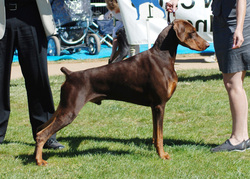
Group
Group 6 (Utility) General Appearance Medium size, muscular and elegant, with well set body. Of proud carriage, compact and tough. Capable of great speed. Characteristics Intelligent and firm of character, loyal and obedient. Temperament Bold and alert. Shyness or viciousness very highly undesirable. Head And Skull In proportion to body. Long, well filled out under eyes and clean cut, with good depth of muzzle. Seen from above and side, resembles an elongated blunt wedge. Upper part of head flat and free from wrinkle. Top of skull flat, slight stop; muzzle line extending parallel to top line of skull. Cheeks flat, lips tight. Nose solid black in black dogs, solid dark brown in brown dogs, solid dark grey in blue dogs and light brown in fawn dogs. Head out of balance in proportion to body, dish faced, snipy or cheeky very highly undesirable. Ears Small, neat, set high on head. Normally dropped, but may be erect. Mouth Well developed, solid and strong with a complete dentition and a perfect, regular and complete scissor bite, i.e. the upper teeth closely overlapping the lower teeth and set square to the jaws. Evenly placed teeth. Undershot, overshot or badly arranged teeth highly undesirable. Neck Fairly long and lean, carried with considerable nobility; slightly convex and in proportion to shape of dog. Region of nape very muscular. Dewlap and loose skin undesirable. Forequarters Shoulder blade and upper arm meet at an angle of 90 degrees. Shoulder blade and upper arm approximately equal in length. Short upper arm relative to shoulder blade highly undesirable. Legs seen from front and side, perfectly straight and parallel to each other from elbow to pastern; muscled and sinewy, with round bone in proportion to body structure. Standing or gaiting, elbow lies close to brisket. Body Square, height measured vertically from ground to highest point at withers equal to length from forechest to rear projection of upper thigh. Forechest well developed. Back short and firm, with strong, straight topline sloping slightly from withers to croup; bitches may be slightly longer to loin. Ribs deep and well sprung, reaching to elbow. Belly fairly well tucked-up. Long, weak, or roach backs highly undesirable. Hindquarters Legs parallel to each other and moderately wide apart. Pelvis falling away from spinal column at an angle of about 30 degrees. Croup well filled out. Hindquarters well developed and muscular; long, well bent stifle; hocks turning neither in nor out. When standing, hock to heel perpendicular to the ground. Feet Well arched, compact, and cat-like, turning neither in nor out. All dewclaws removed. Long, flat deviating feet and/or weak pasterns highly undesirable. Tail Preferably docked at first or second joint; appears to be a continuation of spine without material drop. Gait/Movement Elastic, free, balanced and vigorous, with good reach in forequarters and driving power in hindquarters. When trotting, should have strong rear drive, with apparent rotary motion of hindquarters. Rear and front legs thrown neither in nor out. Back remains strong and firm. Coat Smooth, short, hard, thick and close lying. Imperceptible undercoat on neck permissible. Hair forming a ridge on back of neck and/or along spine highly undesirable. Colour Definite black, brown, blue or fawn (Isabella) only, with rust red markings. Markings to be sharply defined, appearing above each eye, on muzzle, throat and forechest, an all legs and feet and below tail. White markings of any kind highly undesirable. Sizes Ideal height: Dogs 69 cms (27 ins) at withers Bitches 65 cms (25? ins) at withers Considerable deviation from this ideal undesirable. Faults Any departure from the foregoing points should be considered a fault and the seriousness with which the fault should be regarded should be in exact proportion to its degree. Notes Male animals should have two apparently normal testicles fully descended into the scrotum. |
Fireax Enticing Rhythm winning Best Baby Puppy NSW Dobermann Specialty In ShowAust. Ch. Fireax Viva La Diva wining runner up in group from puppy class at the Spring FairAust. Ch. Fireax Style Quest ET WAC Winning Best In Show Dobermann Specialty under the renowned Bill Sheldon (US)Aust. Ch. Fireax Engaging Image ET WAC winning Best Of Breed at the Sydney Royal Easter ShowAust. Ch. Fireax Engaging Image ETNZ Ch. Fireax Fancy ForceAust. Ch. Fireax Femme Fatale ETAust. Ch. Fireax Striking Image as a Minor PuppyAust. Gr. Ch. Fireax Supreme ValourAust. Grand Ch. Fireax Twice The Valour ET WAC winning best Male and Runner Up Best Of Breed at the Dobermann Nationals.Fireax Visions And Dreams as a puppyAust. Ch. Fireax Viva La LeyendaAust. Ch. Fireax Style Quest ET WACAust. Ch. Fireax Thunder Storm ETFireax Xtra VagantAust. Ch. Fireax Thunder Storm ETAust. Ch. Viva La LeyendaAust. Ch. Fireax Twice The Valour ET WACAust. Ch. Fireax Thunder Storm ETAust. Ch. Fireax Enticing EnvyAust. Ch. Fireax Enchanting ImageAust. Ch. Fireax Love N XXXsAust.Ch. Fireax Twice The Fun ET WAC |
